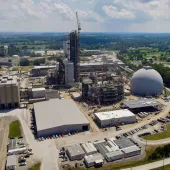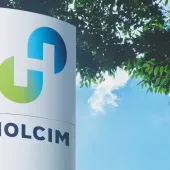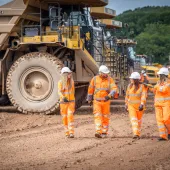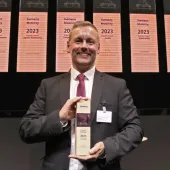Successful outcome for decarbonization collaboration
Mannok and FLSmidth deliver significant step forward in the decarbonization of cement production
MANNOK and FLSmidth are celebrating the successful implementation of the FUELFLEX Pyrolyzer, a new combustion system which has almost eliminated the use of fossil fuel in the most carbon-intensive stage of cement production at Mannok’s plant, reducing 240 tonnes of carbon emissions per day (comparable to the annual carbon emissions of a medium-sized town with a population of approximately 5,000 people), whilst also significantly reducing NOx emissions.
To mark this milestone in the completion of this international R&D project, which is set to transform the cement manufacturing industry and help Mannok’s cement production be more sustainable, the two companies held a launch event with politicians, stakeholders, industry experts, government agencies, local councils and schools from the Republic of Ireland, the UK and Denmark attending.
The new FUELFLEX system is allowing Mannok, at present, to replace 90% of their coal use with SRF (solid recovered fuels), that would otherwise go to landfill, in the pre-calcination stage of cement production and it is working towards eliminating the use of coal.
FLSmidth, the Danish engineering company which created the new technology, partnered with Mannok on the development of the world’s first pilot of the FUELFLEX Pyrolyzer in 2018, and during the event on 30 March 2023, Lars Skaarup Jensen, FLSmidth’s research and development specialist, outlined the collaboration between the two companies in the design and testing of the system over the last four years.
‘When we reached out to Mannok, FUELFLEX was still very much at concept stage,’ he said. ‘We’d performed some testing in our lab in Denmark, but that is very different to deployment in a fully operational cement works. With the development and testing of completely new technology like this, you can expect it to throw up some issues along the way, and this pilot was not without its challenges. It required design revisions following initial tests to ensure continuous running of the FUELFLEX, which involved expertise from both Mannok and FLSmidth.
‘These revisions addressed issues which could only be identified through real-life testing, and we are very pleased that the system has now been running smoothly and effectively and has remained in operation for around nine months now. It was a brave decision by Mannok to partner with us in the development of this world-first technology, and it took great commitment and expertise on both sides to achieve a successful outcome which has enormous potential for cement producers globally.’
With the technology operating successfully at the Irish producer’s facilities since July 2022, it has already allowed Mannok to cut their fossil fuel use in the cement production process and could be a game changer for the industry, having already gained international attention with delegations from Europe and Asia visiting the Irish plant in recent months to see the FUELFLEX in action.
The production of clinker, a precursor to cement, is the most fuel-intensive part of the process, and the pre-calcination phase accounts for the largest portion of fossil fuel use – 60% of all fossil fuels in Mannok’s case. The ability to completely displace this use of coal is undoubtedly a major leap forward for the industry, and for Mannok, a company which has clearly and publicly defined its ambitious decarbonization targets.
Operations director Kevin Lunney explained: ‘The key challenge for the entire cement industry is decarbonization, and it’s our primary area of focus. We’ve set ambitious targets to reduce our carbon emissions by a third by the end of the decade, and to go on to achieve net zero by 2050. This requires innovative thinking and we’re very proud to partner with FLSmidth and to help provide leadership in this space.
‘The success of the FUELFLEX technology is a big win for us, as we are now on track to eliminate all coal use in the pre-calcination phase of production, which surpasses our initial expectations of displacing 80%. This will remove around 40,000 tonnes of coal and the resulting 58,000 tonnes of carbon emissions per year, so it’s a significant leap forward in our decarbonization journey.’
Another environmental benefit of this new technology is the reduction in nitrogen oxide (NOx) emissions, which the team at Mannok had not really expected to achieve at the outset. There are very strict limits to permitted NOx emissions, and Mannok, like many cement producers, have used significant quantities of ammonia water to ensure compliance with these regulatory limits.
Since the introduction of FUELFLEX, however, the company has almost eliminated its use of ammonia water and is running at around 20% below its permitted NOx limits on occasion, which has brought an unexpected commercial benefit by significantly reducing the previous need for 48,000 litres of expensive ammonia water per week.
The new FUELFLEX system achieves all of this by allowing the increased use of SRF as an alternative energy source to coal in the pre-calcination stage. The SRF is non-recyclable commercial waste, which would otherwise go to landfill, so this also serves a very beneficial waste-management purpose.
Damian Reilly, cement general manager at Mannok, explained: ‘We’ve been using SRF in our clinker production since 2014 and have progressively displaced more coal, until we reached maximum capacity with our existing calciner set-up. As a new combustion system which improves the efficiency of our existing set-up, the FUELFLEX technology is set to enable full coal displacement with SRF in our pre-calcination process.
‘The SRF we use is sourced from the counties immediately surrounding the plant, so we’re reducing shipping costs and carbon footprint of imported fossil fuels by increasing our capacity to replace it with locally sourced SRF. As well as the obvious environmental benefits, this SRF is a much more commercially viable fuel source, particularly given the surging energy costs, and the more SRF we can use in Ireland, the less will be exported to cement kilns across Europe, so it’s a win-win.’
With such significant environmental and commercial benefits, FLSmidth say their FUELFLEX technology is likely to become a feature of cement production works across the globe, and for Mannok, this is the first major success in the company’s pursuit of net zero, with further significant innovation in sustainable energy already under way.
Commending the local company for this successful innovation, Eugene Heaney, green economy business development manager at Invest Northern Ireland, said: ‘I think the new FUELFLEX technology is a terrific innovation from a locally based company straddling the border here between Northern Ireland and the Republic of Ireland. At present, the cement industry is responsible for 7% of the global emissions and 4% in Europe, and this new technology that Mannok and FLSmidth are showcasing will decarbonize the industry and help it move towards net zero.
‘Mannok have shown great ambition and foresight in investing in this project. The collaboration and the partnerships that they’ve formed show great understanding of the challenges that the cement industry faces. It’s an industry that is very important to economic development and it’s great to see that Mannok have taken that ‘leap of faith’ to move their business forward and hopefully it will be an incentive for the rest of the industry. For both Northern Ireland and the Republic of Ireland to have such an innovative company in this space, is terrific.’
During the launch event, both Mannok and FLSmidth explained how the development of this innovation was a trial-and-error process, as nothing like it had been done before. Tom Kelly, head of industrial and life sciences at Enterprise Ireland was very impressed by this. He said: ‘FUELFLEX technology is highly innovative, which is testament to the work of FLSmidth and Mannok who have developed and applied it. It took several years to bring it to the implementation stage, so it is really impressive that Mannok chose this option, especially as there were alternative strategies that they could have pursued. But they embraced the innovative FUELFLEX Pyrolyzer courageously.
‘Mannok’s willingness to invest in this R&D project is probably the most notable part. It requires courage to invest in a technology not yet proven but one that offers great promise, and it demonstrates there is great leadership within the management of Mannok. The company’s willingness to collaborate in the development of a new technology is also important to note, as collaboration is critical to innovation.’







